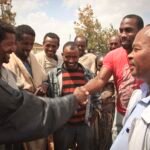Humanitarian entities working in Ethiopia have appealed for additional funding to provide food rations to over 750,000 refugees in the country.
The World Food Programme (WFP), the United Nations High Commissioner for Refugees (UNHCR), and Ethiopia’s Refugees and Returnees Service (RRS) say about U.S.$73 million is needed to provide food assistance to refugees for the next six months.
WFP, in a statement, said it will completely run out of food for refugees by October 2022 due to a funding shortfall, leaving families at risk of undernutrition, micronutrient deficiency, and susceptibility to diseases and infections.
The UN agency has already been forced to cut food rations for 750,000 registered refugees living in 22 camps.
Food insecurity amongst refugees has risen as a result of the cut in rations, further compounded by current global limitations to food availability, economic and climate shocks, the rising cost of food, and insecurity.
‘Three-quarters of a million refugees will be left with nothing to eat in just a matter of weeks unless we receive funding immediately’, WFP’s Representative and Country Director for Ethiopia, Claude Jibidar, said.
‘The priority for us all must be to restore assistance to at least minimum levels for refugees, all of whom are solely reliant on WFP’s cash and food assistance for survival.
‘We have a shortfall of U.S.$73 million for refugees’ minimum needs and we are deeply concerned that if funding cuts continue, they may consider returning to their places of origin when it is unsafe’.
It is understood that WFP, UNHCR and RRS have established a system to identify the food assistance needs of refugees through biometric verification.
Ethiopia has long been a generous host to refugees and its policy response to forced displacement has been progressive.
It is the third largest refugee hosting country in Africa and the ninth largest worldwide. Most refugees in Ethiopia originate from South Sudan, Somalia, and Eritrea, and face protracted displacement due to regional instability. They reside in camps, which are generally located on the periphery of the country.
It was gathered that the government of Ethiopia has agreed to third-party implementation and monitoring in areas at high risk of ongoing conflict to ensure that needs in all refugee-hosting areas in the country are met.
Photo source: World Bank






